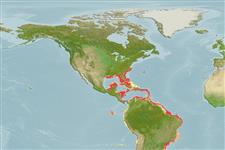Environment: milieu / climate zone / depth range / distribution range
Ecologie
marien rifbewoner; diepte 3 - 320 m (Ref. 9710), usually ? - 60 m (Ref. 93218). Subtropical; 37°N - 30°S, 95°W - 34°W
Western Atlantic: Bermuda, North Carolina (USA) and northern Gulf of Mexico to Santa Catarina, Brazil (Ref. 57756). Most common lizard fish in the West Indies (Ref. 13442).
Grootte / Gewicht / Leeftijd
Maturity: Lm ? range ? - ? cm
Max length : 46.0 cm TL mannelijk / geslacht onbekend; (Ref. 26340); common length : 40.0 cm TL mannelijk / geslacht onbekend; (Ref. 5217); max. gepubliceerd gewicht: 1.0 kg (Ref. 5217)
Dorsale stekels (totaal) : 0; Dorsale zachte stralen (totaal) : 11 - 12; Anale stekels: 0; Anale zachte stralen: 11; Wervels: 49 - 52. This species is distinguished by the following characters: D rays 11-12; A rays 11; total caudal rays 40-42; dorsal segmented caudal rays 9; ventral segmented caudal rays 9-10; dorsal procurrent caudal rays 11-12; ventral procurrent caudal rays 9-10; pelvic-fin rays 8; pectoral-fin rays 11-13; total vertebrae 49-52 (modally 50); pored lateral-line scales 49-52 (modally 51); median predorsal scales 16-17; scale rows on cheek 6-8; HL 15.2-28.4% SL (26.6%); orbit diameter 3.6-6.4% SL (4.7%) and 13.4-22.5% HL (17.2%); interorbital width 2.8-5.3% SL (4.3%) and 10.1-19.4% HL (15.9%); flap on anterior nostril is small and broad, its length 1.5-3.6% HL (2.4%); snout triangular in dorsal view; pelvic-fin length 23.1-26.7% SL (24.9%); when preserved, 3-6 dark bars on caudal fin spanning upper and lower lobes; with a small, rectangular-shaped, black scapular blotch (length 5.1-12.2% HL, mean 8.4%); there are 9-13 dark bars on trunk; colour in life, adults tan to olive and with unevenly distributed yellow stripes along body (Ref. 93218).
Found on the sandy bottom around boulders or in sandy corridors in patch reefs (Ref. 5521). Uncommon near the shore.
Levenscyclus en paargedrag
Maturities | Voortplanting | Spawnings | Egg(s) | Fecundities | Larven
Robins, C.R. and G.C. Ray, 1986. A field guide to Atlantic coast fishes of North America. Houghton Mifflin Company, Boston, U.S.A. 354 p. (Ref. 7251)
Status op de Rode Lijst van het IUCN (Ref. 130435)
Gevaar voor de mens
Harmless
Gebruik door de mens
Visserij: van minder commercieel belang; Aquarium: Commercieel
Tools
Speciale rapporten
Download XML
Internetbronnen
Estimates based on models
Preferred temperature (Ref.
123201): 17.2 - 27.1, mean 23.2 °C (based on 246 cells).
Fylogenetische diversiteitsindex (Ref.
82804): PD
50 = 0.5000 [Uniqueness, from 0.5 = low to 2.0 = high].
Bayesian length-weight: a=0.00447 (0.00211 - 0.00945), b=3.16 (2.99 - 3.33), in cm total length, based on LWR estimates for this Genus-body shape (Ref.
93245).
Trofisch niveau (Ref.
69278): 4.2 ±0.5 se; based on diet studies.
Weerstandsvermogen (Ref.
120179): Gemiddeld, minimale populatieverdubbelingstijd 1,4-4,4 jaar (Preliminary K or Fecundity.).
Fishing Vulnerability (Ref.
59153): Moderate vulnerability (36 of 100).
Nutrients (Ref.
124155): Calcium = 24.3 [7.8, 53.3] mg/100g; Iron = 0.458 [0.157, 1.050] mg/100g; Protein = 16.5 [13.6, 18.9] %; Omega3 = 0.105 [0.036, 0.259] g/100g; Selenium = 23.1 [8.5, 53.7] μg/100g; VitaminA = 52.7 [12.8, 194.3] μg/100g; Zinc = 0.536 [0.307, 0.875] mg/100g (wet weight);
